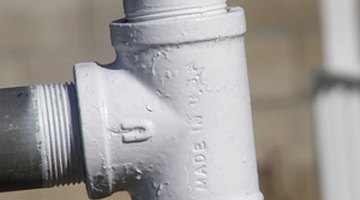How to Replace a Galvanized Water Pipe
Galvanized plumbing pipes are not as widely used as they once were for two reasons. The first is that plumbers have come to realize that they corrode over time, creating internal blockages that inhibit water flow. The second is that copper and plastic pipes are much easier to install and maintain.

Things You Will Need
- Hacksaw
- Bucket
- 2 pipe wrenches
- Teflon tape
- Galvanized nipple
- Galvanized union
- Measuring tape
To replace a length of galvanized pipe, you will need a union, which is a special fitting connected by a large nut. This allows you to install a threaded pipe without actually having to turn the pipe itself.
-
Shut off the valve controlling the water to the pipe you want to replace.
-
Saw through the pipe with a hacksaw. Have a bucket handy to catch the water that will spurt from the pipe as you cut through it.
-
Remove 1/2 of the pipe from the fitting it is screwed into with two pipe wrenches. Hold the fitting with one wrench and the pipe with the other, and turn the pipe counterclockwise with respect to the fitting. When you have removed this half, remove the other half in the same way.
-
Inspect the fittings to which the pipe was connected for signs of corrosion and replace them if they no longer appear serviceable. If they are not damaged, screw a 6- to 10-inch length of galvanized pipe, called a nipple, into one of them. Wrap Teflon tape around the threads on one end of the nipple and screw it clockwise into the fitting. When you can no longer turn it by hand, tighten it with a pipe wrench. Hold the fitting steady with the other wrench while you do this.
-
Wrap Teflon tape around the other end of the nipple and screw on a galvanized union. This fitting has two female ends joined by a large hex nut. When the union is installed, measure the distance from the edge of the nut to the ends of the threads of the fitting to which you will attach the replacement pipe, using a measuring tape. This measurement will tell you the length of pipe you need.
-
Unscrew the hex nut on the union and remove the half that comes loose. Screw it on to one end of the replacement pipe, after wrapping tape around the end of the pipe, and tighten it with a wrench. Wrap tape around the other end of the pipe and screw it into the fitting in the water line.
-
Fit the end of the pipe with the half of the union attached to it into the hex nut on the union, then tighten the nut with a wrench.
-
Turn on the water and check for leaks. If any fitting besides the union leaks, turn off the water, unscrew the union, and tighten the leaking joint. Screw the union back together and turn the water back on. If the union leaks, tighten the nut with a wrench.
Tip
It is possible to replace galvanized steel pipe with copper. To do this, use a dielectric union at each steel/copper joint. This is to prevent corrosion produced by the electric charge that these dissimilar metals produce when touching each other.
Warning
Always use two wrenches to tighten and loosen galvanized joints. If you don't, you can inadvertently loosen a connection at another point on the water line.
References
Resources
Tips
- It is possible to replace galvanized steel pipe with copper. To do this, use a dielectric union at each steel/copper joint. This is to prevent corrosion produced by the electric charge that these dissimilar metals produce when touching each other.
Warnings
- Always use two wrenches to tighten and loosen galvanized joints. If you don't, you can inadvertently loosen a connection at another point on the water line.
Writer Bio
Chris Deziel has a bachelor's degree in physics and a master's degree in humanities. Besides having an abiding interest in popular science, Deziel has been active in the building and home design trades since 1975. As a landscape builder, he helped establish two gardening companies.
Photo Credits
- pipe fitting image by Joann Cooper from Fotolia.com
- pipe fitting image by Joann Cooper from Fotolia.com
More Articles


